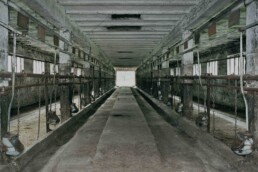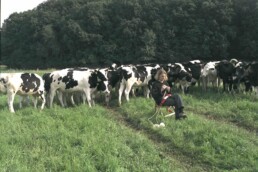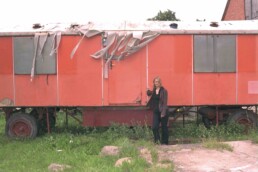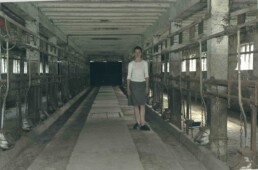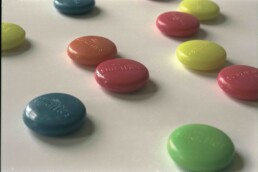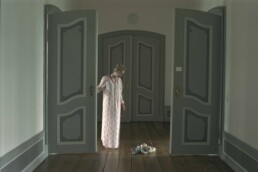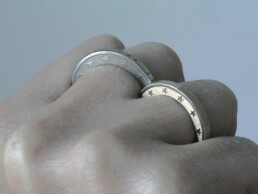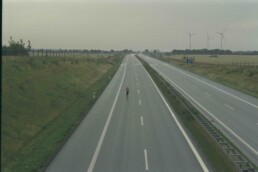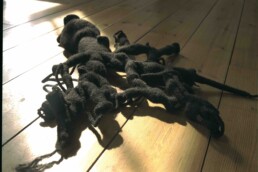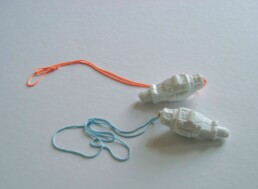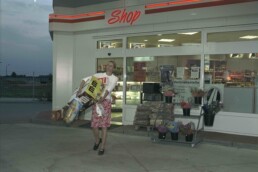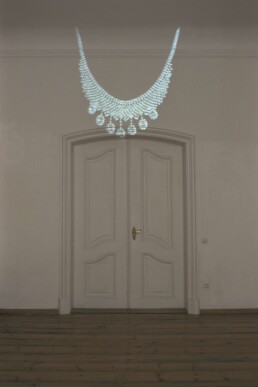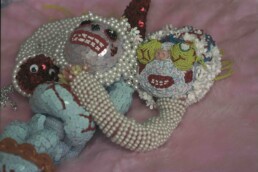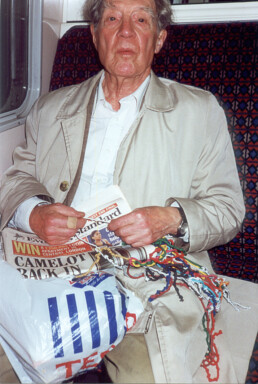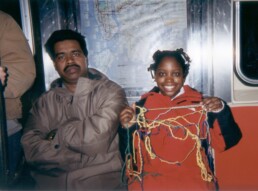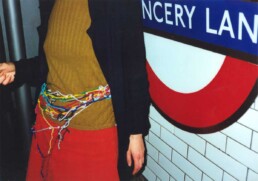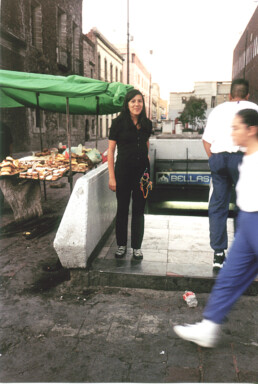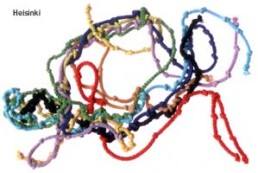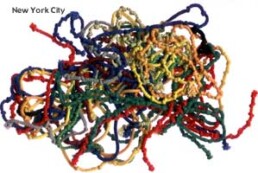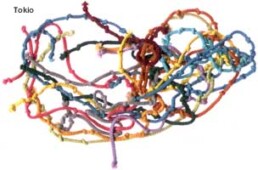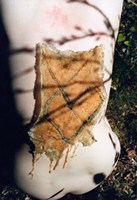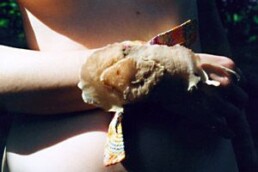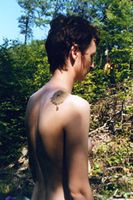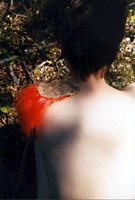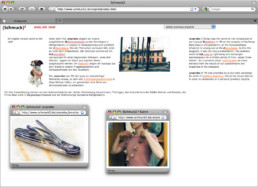Simple Beads and Cultured Seeds
04
2002/03
An international two weeks workshop at the Mecklenburgisches Künstlerhaus Schloß Plüschow, in Germany, which featured some of the key aspects of SCHMUCK2: site specificity, cross-disciplinarity, educational exchange, photographic documentation and its printed dissemination, and custom-made works that reconfigure both jewellery and the public space. Collaborating Artists: Kimmo Heikkilä (FI), Anja Knecht (DE), Tuija Helena Markonsalo(FI), Okamoto Mitsuhiro (JP), Susan Pietzsch (DE), Valentina Seidel (DE) and Ines Tartler(DE).
Results were presented in an touring exhibition at: the Mecklenburgisches Künstlerhaus Schloß Plüschow, the Güstrow Castle and the Public Museum Schwerin(DE), the Kyoto Art Center(JP), the Triennale for Experimental Jewellery Koru at Galeria Rantapaja(FI).
Funded by the Ministry of Culture of Mecklenburg-Western Pomerania, the Cultural Office of the City of Bad Doberan, the Stiftung Kulturfonds, the Consulate General of Finland in Hamburg, the Nomura Foundation Japan and the Goethe Institute in Kyoto/Japan.
Kontakträume
03
2001
In 2001 SCHMUCK2 presented a two-part exhibition under the title „Kontakträume – Neuer Schmuck“ (Contact Rooms – New Jewellery) in the Kunsthalle Rostock in Germany. The exhibition was the first to launch the international exchange that SCHMUCK2 focused on in subsequent projects. Selected works from countries of the Baltic region gave an insight into striking positions of the contemporary jewellery scene in the north. The first exhibition showed jewellery by Janine Arnold(DE), Helle Bjerrum(DK), Margaret Bridgwater (DK), Tuija Helena Markonsalo (FI) and Matti Mattsson (FI) as well from Ulrika Swärd(SE) . Additional the video installation “Valentina Ballerina” by the German photographer Valentina Seidel was shown.
The second exhibition opened with a theater performance entitled „Alles stimmt nicht“ (All is not right) choreographed by the German artist Chat Linder.
Members of the Hibernate Group – Kimmo Heikkilä, Helena Lehtinen, Eija Mustonen and Tarja Tuupanen (FI), Kati Nulpponen(FI) and Karina Noyons(DK) showed their works.
Quotations from the visitors book
What is young * What is jewellery * What is art * Phantastic pieces of jewellery * Great presentation! * Jewellery has to be wearable, this here is not – only worth looking at. Is that a shame? * Wearing this jewellery requires courage. Why shouldn’t one have it? And not only for wearing jewellery. * Strange shapes, things!! Material, too. Pity, jewellery I imagine differently. * Crappy exhibition real crap. * The journey was worth it. New and different! Very beautiful exhibition.
What are you wearing? Jewellery!
02
2000
What are you wearing? – Jewellery! was the motto of a workshop held in July 2000 „Unter den Kolonnaden“ in Heiligendamm on the Baltic Sea.
Four artists; Michaela Sadlowski, Valentina Seidel, Ulrike Solbrig and Susan Pietzsch, each worked out their personal interpretation of “jewellery” in a broader sense. Against their background of very different artistic working methods, objects, photographs and video recordings were created during the workshop. Jewellery was staged as an artistic medium and explored as a means of expression. With the project “What are you wearing? – Jewellery! SCHMUCK2 generally paved the way for collaborative approaches between different artistic media – in this case a jewellery designer, contemporary artists and photographers.
At the end of the workshop the results were presented to the public in Heiligendamm and Bad Doberan and found their way into further exhibitions.
Ulrike Solbrig
Subway Map…to be worn on the side, through a belt loop, for instance. The map is soft, colorful, light, and in a certain way without form and orientation. This lack of orientation resembles the reality of going by subway, because there we are only able to locate ourselves with the aid of schematic maps. This ornament is a translation from 2-dimensional subway maps into a real net. The knots represent the single stations, the colored threads the subway lines. The knots build a bridge from merely an abstract representation of thought to tangible, reproducible stations. Similar to the pearls of a rosary, one can follow the knots with the hand, just as one’s body travels between the subway stations. If you go by subway you are part of the system, quite the opposite of holding this little map in your hand. The map is in many ways similar to a talisman: as small representation of an object one can not handle – an amulet built of knots. Either take the map along while travelling by subway or keep it as a souvenir of whatever city you like best.
Michaela Sadlowski
I found this place fascinating and special where the project What are you wearing? – Jewellery! took place: in the momentarily empty white town by the sea, Heiligendamm. This place by the Baltic Sea, which is full of history, doesn’t only show traces of the past on and in the white villas standing by the water but it is also nature which bears those traces. Near the villas is a wood close to the cliffs. This wood, typically called “ghost wood”, has something very mystic and weird about itself, it seems very full of soul. Interestingly enough, visitors have over decades immortalized themselves in this wood by carving and scratching various signs into the bark of the trees. Also I found several sensuous and interesting shapes in the bark. Those shapes I have cast in latex and I projected them onto the human body by transforming the latex casts into wearable pieces of jewellery. I took photographs of the jewellery on naked skin so that they seem like distortions on the body, making a possible history of the individual body visible.
Susan Pietzsch und Valentina Seidel
The work ‘Cutie Pie’ is a collaboration between jewellery designer Susan Pietzsch and photo artist Valentina Seidel. Bodies were processed with various materials from the food sector (icing, candy), and in this process new images and definitions of jewellery were created. The proximity to tatoos and cake decorations is intentional, their transience integral to the works. The bodies become macro landscapes, projection surfaces of erotic desires and oral pleasures, expressions of longing and constructs of transience. The documentation was created by means of photography and video, it shows an autonomous artistic interpretation of the works created.
Funded by the Ministry of Culture of Mecklenburg-Western Pomerania, the Cultural Office of the City of Bad Doberan, Baltic Color in Bargeshagen/Rostock and the Volks- und Raiffeisenbank eG Bad Doberan.
:anprobe
01
1998/99
:anprobe(fitting) was the launch project for SCHMUCK2 in 1998/99 after its founding in 1997. With :anprobe, SCHMUCK2 aimed to significantly expand the scope of impact for contemporary jewellery. To this end, the project docked onto various public cultural events in several cities in Germany.
On the occasion of the Horse Racing Days in Heiligendamm, the “euro-scene” in the Schauspielhaus in Leipzig, the European Capital of Culture Weimar 1999 and others. Four artists: Inka Bergmann, Dörte Dietrich, Nina Klatt and Susan Pietzsch installed a mobile exhibition designed by Tom Kühne whose exhibits (pieces of jewellery) were offered for temporary exchange for a personal piece of jewellery.
The traveling exhibition was preceded by a two-week workshop, for which the artists and jewellery designers met in the legendary “Haus Weimar” in Heiligendamm to each develop their own jewellery objects.
Temporary owners of the jewellery were archived via Polaroids.
At the same time, questionnaires included in the return packages offered with the exchanged piece documented the experiences of the wearers.
Excerpts from the questionnaires
What was the reaction of friends and strangers?
interested * amused * they were delighted, both of the jewellery as well as the idea * one has to get used to it * strange * funny * very extravagant * very mixed actually, although most people judged the jewellery as very witty and unusual * positive * people often approached me: “Oh, designer jewellery, arty jewellery”, also: “Did you make that yourself?“ * from disapproval to enthusiasm * some were frightened of what I had on my shoulder “iiih” * interest in the jewellery-swapping-business * understanding of the particularity of the piece * You and jewellery! What’s that?
How often and what occasions did you wear the jewellery on?
In the four weeks lending time I wore the jewellery very often in order to give my everyday life and my appearance a special touch * very often * on various occasions, theatre, office… * day and night actually, and it was fun wearing the “fly” on the shoulder * at the opera * the theatre * in my free time * almost every day * at work * at home * when meeting friends * extremely often * to every party & even at school I couldn’t get my fingers off the piece * for the international days of the research of the Baltic Sea in Stockholm * rather seldom * concert * celebration of the town district * at the disco * almost every day * to work * to parties * theatre * on journeys * on my backpack
What kind of relation did you build up towards the jewellery?
I was worried about losing the donkey * I knew I would stand out * It was a therapeutic aid, the therapy was: come out of your shell, dare something new. * It was so to speak love at first sight. * I got used to it * I feel good with it my dear fly on the shoulder has become my “company/clothes pet”. I don’t like giving away the piece, therefore the late return. * A wonderful weekend in Leipzig. * I regarded the jewellery as my own during the time of wearing, and was often pleased with it because I liked it a lot and others appreciated it. * Initially I felt permanently insecure, that the jewellery might break or stand out unpleasantly, I felt like someone special. * At first I had to get used to it, but it’s fun that people talk to you because of certain jewellery. * I enjoyed it very much to be the centre of attention, for example at parties. * From my understanding of jewellery the piece was rather too large. * I have a rather sceptical attitude towards such kind of jewellery.
Comments
I’d like to know something about the history of my piece, who did also wear it? * The reaction of all people who saw this donkey brooch was interesting for me too – it showed how one gets perceived. * My wife found the jewellery too symmetrical, nevertheless, a nice experiment, the campaign was fun, thanks to everybody. * Very young imaginative jewellery, but not always wearable being so relatively dominant. * Perhaps I’ll remain an unadorned type, I noticed that I judge all things by function and practical quality. * I find the idea super and would like to know more about your activities. * Thank you very much and every success to everybody involved. * I hope we will see each other next year at the EuroScene in Leipzig. * Great idea! * It really drew my attention to new jewellery! * Thank you very much! In case you lend more jewellery let me know!
Exhibition design: Tom Kühne
Graphic design: Jan Kny
Funded by the Ministries of Culture of Mecklenburg-Western Pomerania, Thuringia, the Cultural Offices of the cities of Weimar and Rostock, the company Neon-Licht in Bargeshagen/Rostock and the Development Company Heiligendamm.
